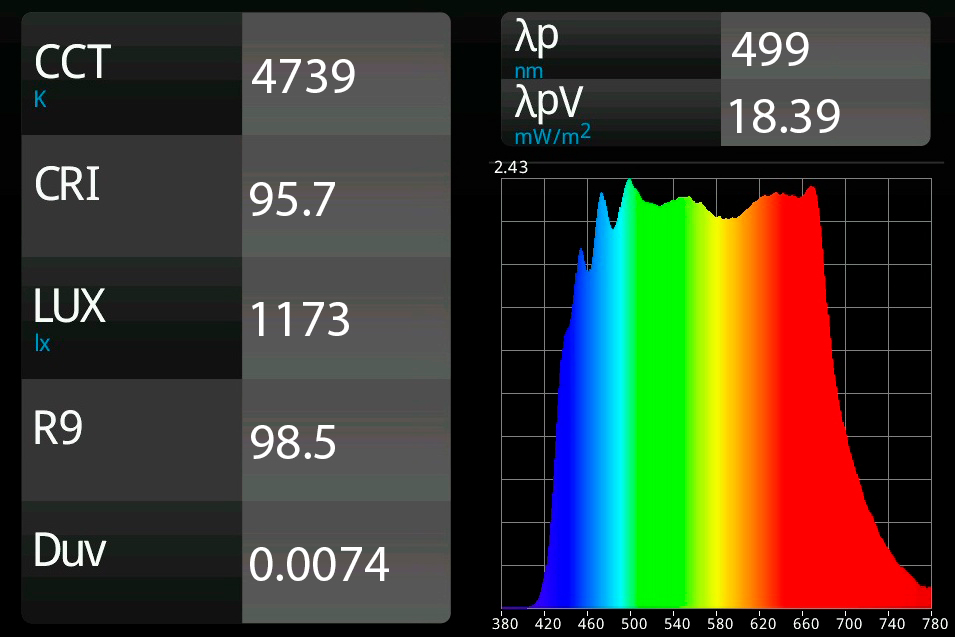Procognitive effect
The intensity of the emitted light in the procognitive region (460-500 nm with maximum at 480 nm) of Spectrasol illumination is balanced with the light energies of the surrounding wavelengths, i.e. the spectrum is continuous. Other white light sources have a typical drop in this area or suffer from high radiation intensity in the HBL area (harmful blue light) as side effect of an effort to balance the spectrum (415-455 nm).
To understand and define circadian efficacy and procognitive action, we define two regions in the visible spectrum (from violet to red) wavelengths:
- visual sensitivity curve that includes the region of the visible spectrum to which human vision is most sensitive – this curve therefore represents the photopic visual system of the eye mediated by the retinal cones and has a maximum at 555 nm,
- and the melanopic curve, which includes the region of the spectrum to which the human circadian system is most sensitive to (i.e. circadian entrainment, alertness, cognitive performance) – this curve therefore represents the non-visual system of the eye, which is primarily mediated by the so-called internally sensitive melanopsin ganglion cells of the retina (ipRGC cells, from English intrinsically photosensitive retinal ganglion cells) containing the light-sensitive photopigment melanopsin [5], [8]-[10].
Melanopsin has an absorption maximum ranging from 464 to 484 nm, sometimes reported as low as 447 nm [10]. This maximum is not precisely defined yet – this is not only due to the different methodology of the studies, but also due to the fact that melanopsin exhibits bi-stability, which may affect its spectral sensitivity [10], [11]. In addition, there are at least five types of ipRGC cells that differ in their morphology and function. Other photoreceptors also play a role in the non-visual system. Short wavelength-responsive cones (S-cones) have been shown to contribute to circadian phase shift, especially in the first 1.5 h of light exposure, then melanopsin-expressing ipRGCs take the lead. S-cone’s sensitivity peak is at approximately 439 nm. [5], [9], [12]-[14]. However, despite these complex interactions and effects, most scientific data show that the maximum lies in the region of around 480 nm [9], [10]. Since the melanopsin absorbance is defined by a function and not a specific point, the melanopic procognitive region can generally be defined as the range 450-500 nm and especially 460-490 nm [5], [8]-[10]. Stimulation of melanopsin during the day is essential for circadian entrainment, mood, alertness and cognitive performance [3], [5]-[7], [15]-[17]. Exposure to a balanced full-spectrum light without any dips in the melanopic region is therefore extremely important during the day [6], [8]-[10], [18]-[20]. This is also why the International Commission on Illumination (CIE) recommends maximising exposure to full-spectrum daylight during the day not only outdoors, but also indoors [19].
An unbalanced discontinuous spectrum usually has a low insufficient CRI value with LED sources typically lacking in red spectral emission. CIE confirms that light that is insufficient for the visual (sight) or non-visual system of the eye, or light that has an imbalance between the effects on both systems or is inadequate for one or both systems, can harm human health [19].
Summary and comparison of the procognitive effect of light sources
The procognitive light source effect describes the effect on the non-visual system of the eye, i.e. the quality of radiation in the circadian cyan and neighbouring blue and green regions, also known as the melanopic region. It is a region defined by 460-500 nm (with a maximum at 480 nm) that signals the human brain that it is in fact daytime. As a result, it entrains the circadian system and supports wakefulness and cognitive performance of the brain.
- The fluorescent lamp has minimal to zero radiation in this region.
- A conventional LED light source has a typical drop in radiation right in this melanopic region, which is preceded by concentrated energy in blue wavelengths; this drop is caused by fundamental limitation of luminophore in LED technology.
- The Spectrasol LED light source emits continuous and balanced energy across the full visible spectrum, i.e. the spectrum is continuous also in the melanopic procognitive region and analogous to the Sun.
- The sun at noon has a fully continuous spectrum, i.e., it also emits continuous and balanced energy in the melanopic procognitive region of the visible spectrum.


